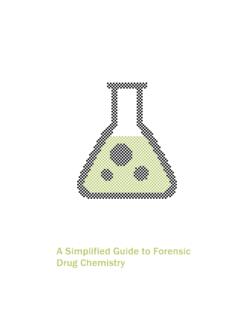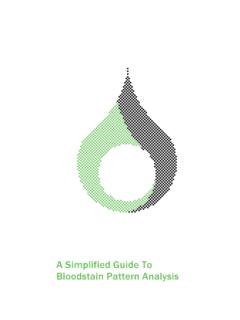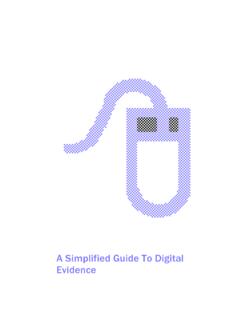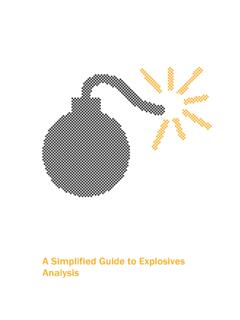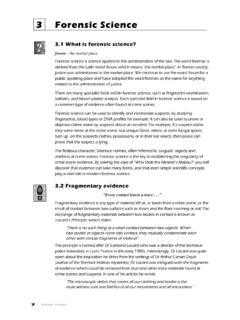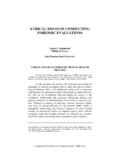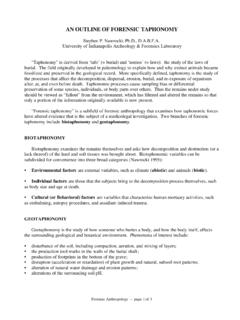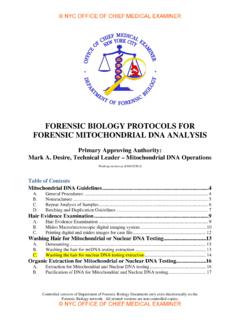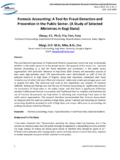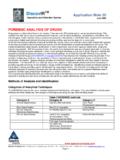Transcription of A Simplified Guide to Forensic Toxicology
1 A Simplified Guide to Forensic Toxicology Introduction From Socrates, sentenced to drink hemlock in 399 , to Russian mystic Grigori Rasputin reputedly living despite ingesting ten times the fatal amount of cyanide in 1916, and even fictional Sleeping Beauty, poisoning has been a popular way to bring an end to an adversary in real and imagined stories for thousands of years. Until 1840, poisoning was often thought to be a way to get away with murder , and it worked because there were no visible signs of foul play.
2 In that year, a French woman named Marie Lafarge became the first person to be convicted of murder by poisoning thanks to new methods for arsenic testing, and the field of Forensic Toxicology was born. Toxicology is the study of the adverse effects of chemicals on living organisms. Forensic Toxicology takes it a step further, including a number of related disciplines to assist in the detection and interpretation of drugs and poisons in medicolegal death investigations, human performance issues; , driving under the influence, compliance and other related matters.
3 In these investigations, the three main objectives (respectively) are to: Establish if toxicants are present and capable of contributing to death Establish if toxicants are present and capable of causing behavioural changes Establish if substances are present and whether or not they represent legitimate use or exposure, such as prescribed medications or workplace exposures Forensic Toxicology can also be used to determine drugs and dosing for hospital patients.
4 For example in therapeutic drug monitoring and emergency clinical Toxicology ; identify crimes where toxicants are used to poison or sedate; resolve cases of driving under the influence; and establish whether drugs have been used to improve human performance, as in sport doping . For the purposes of this module, we will be primarily discussing post- mortem Forensic Toxicology . Principles of Post-mortem (Death Investigation) Forensic Toxicology Sixteenth century scientist Paracelsus gave us the adage the dose makes the poison.
5 Basically, he surmised that a certain amount of every substance, even water and air, can be toxic and those amounts can differ somewhat from person to person and substance to substance. Therein lies one of the most basic challenges of Toxicology : is it the quantity of the toxin or the make- up of the person? Forensic Toxicology applies analytical Toxicology to the purposes of the law, and includes the analysis of a variety of fluids and tissue samples to determine the absence or presence of drugs and poisons.
6 Once the analytical component is complete, the toxicologist has the equally challenging aspects of interpreting the findings. Applications Why and when is Forensic Toxicology used? In post- mortem investigations, suspected drug overdoses are clear situations where Toxicology is required to establish if an excessive intake of the drug occurred and, if so, whether this contributed to death. Conversely, Toxicology can eliminate the possibility of a drug overdose if concentrations are not capable of causing death, given all other factors.
7 This means that Toxicology testing can produce a positive result even in cases where drug use is not mentioned in the police circumstances. This is not surprising given the wide availability of potentially toxic substances, both legal and illegal. In addition, concentrations of substances change after death making any interpretation difficult, no matter the concentration. In many cases, poisons may be detected by the Toxicology laboratory but are not necessarily a cause of death, rather their presence may be relevant in the circumstances of death.
8 For example, alcohol and impairing drugs are found in about half of all drivers killed in motor vehicle crashes in Australia, nearly one- third (31%) of all traffic- related deaths in the United States and in a significant proportion of other accidental deaths. Alcohol and/or drugs are also found in a significant number of other deaths reported to the coroner; for example, in suicides that include non- drug related intentional deaths.
9 In death cases where natural disease is partially to blame, drugs that indicate an underlying disease are often detected, such as drugs that have been used to treat a condition or pain. Sometimes these drugs are regarded as contributing to the cause of death. Regardless how the individual died, Toxicology testing can determine whether levels of toxic substances may have contributed to this death. How It s Done How the evidence is collected Specimens sent for Toxicology testing are usually collected by the Forensic pathologist (who may also be an appointed medical examiner or coroner in some jurisdictions) or mortuary technician during an autopsy.
10 Specimens must be properly identified, labelled and sealed as soon as practicable after collection. All specimens pertaining to a case must be collected and bagged separately in tamper- proof containers. Unique numbered seals are used to track all evidence for each case. Like any other evidence, the chain of custody must be preserved at all times, from the mortuary through the laboratory testing, reporting and storage, for court purposes.
